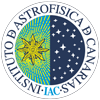Manuela Zoccali

Stay at the IAC: 04/01/2014 to 12/2/2014.![]()
Research line: Stellar and Interstellar Physics
Dr. Zoccali gave a Seminar at the IAC on 2014 January 7th entitled The Milky Way Bulge.
Dr. Zoccali is a Profesor at the Instituto de Astronomia, Pontificia Universidad Católica de Chile.
Dr. Manuela Zoccali finished her PhD in Astronomy at Padova University in 2000 (advisor G. Piotto). After that, she was awarded an ESO Postdoctoral Fellowship (2000-2003) and subsequently a Postdoctoral Princeton-PUC Prize Fellowship (2003-2004). Since 2004 she is a Profesor at the Instituto de Astronomia, Pontificia Universidad Católica de Chile.
Her primary research interests are Stellar Populations, particularly in the Galactic Bulge. She has also done research on stellar clusters, stellar chemical abundances, and the Initial mass function. In 2011, she was awarded a prestigious John Simon Guggenheim Memorial Foundation Fellowship.
Manuela Zoccali's most important contribution to science is her investigation of the stellar content of the central few kiloparsecs of our Galaxy (the “bulge”). She determined with unprecedent accuracy the age of bulge stars, their chemical abundances, and their mass distribution at birth. This observational evidence helps us reconstructing the formation history of the bulge, hence identifying the basic physical processes that have led to its present dynamical structure and stellar content.
Manuela Zoccali's most important contribution to science is her investigation of the stellar content of the central few kiloparsecs of our Galaxy (the “bulge”). She determined with unprecedent accuracy the age of bulge stars, their chemical abundances, and their mass distribution at birth. This observational evidence helps us reconstructing the formation history of the bulge, hence identifying the basic physical processes that have led to its present dynamical structure and stellar content.
Her most cited refereed article (Zoccali et al. 2003) demonstrated that the bulk of bulge stars are about 10 billion year old, thus they have formed early in the life of the Universe. They have a broad distribution in iron content, peaked at a value near solar, indicating a high star formation rate, and relatively high fraction of massive stars. In Zoccali et al. (2000), she used near infrared images from the Space Telescope to derive the mass distribution of the stars, at birth. This is a crucial ingredient in models of galaxy formation and evolution, as it determines the production of heavy elements by the most massive stars, the time evolution of the galaxy luminosity, its mass-to light ratio, its total star formation rate, and the energetic feedback into the interstellar medium. More recently, she derived the first iron content of bulge stars via high resolution spectra (Zoccali et al. 2008), and demonstrated that the bulge 3D structure is such that it must have originated from dynamical instabilities of the disk (McWilliam & Zoccali 2010, Saito et al. 2011).
In this stay she collaborated with members of the project 'Late type galaxies in the Local Universe' (C. Gallart, M. Monelli, C. Martínez), on using data obtained in the "Vista Variable in the Via Lactea (VVV)" survey to obtain the star formation history of the internal Milky Way Bulge, and on the spectroscopic study of RR Lyrae stars in nearby galaxies.


